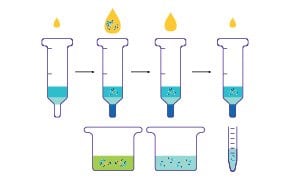Protein Purification

Various of protein purification methods are widely used in the fields of biology and biomedical research. Many varialbes determines the expression and purification process of recombinant proteins, which includes but are not limited to the physical properties and biological functions of the proteins, and also whether bacteria or eukaryotic cell cell lines should be used to express the target proteins. Significant progress has been made in the field of recombinant protein expression and purification methods, while a large number of commercially available systems and reagent kits have emerged. However, proteins are complex macromolecules and the optimal protein expression and purification strategy must be determined based on experience.
Related Technical Articles
- 免疫沉淀(IP)可用于高效、高产量分离和纯化与FLAG®肽标签融合的蛋白质。此过程采用ANTI-FLAG® M2亲和凝胶进行,后者是一种与琼脂糖树脂共价结合的高度特异性单克隆抗体。
- This page shows how to perform sample desalting, buffer exchange and concentration for affinity chromatography of tagged proteins.
- This page shows how to solubilize membrane proteins with products from Cytiva.
- This page describes efficient column packing and preparation for affinity chromatography of tagged proteins using Cytiva products.
- This page covers the use of Sepharose Fast Flow for purification of proteins.
- View the Full Content (82)
Related Protocols
- Reduce plastic waste and eliminate hazardous liquid waste for more sustainable laboratories with GenElute™-E Single Spin DNA and RNA prep kits.
- How to optimize purification of histidine-tagged proteins using Cytiva products.
- This page shows how to separate proteins and peptides with affinity for metal ions by immobilized metal chelate affinity chromatography using HiTrap Chelating HP, Chelating Sepharose Fast Flow,His MicroSpin Purification Module or HisTrap Kit from Cytiva.
- His GraviTrap™ TALON® columns are prepacked with 1 ml of TALON® Superflow medium. Each column provides simple manual purification of up to 15 mg of histidine-tagged proteins.
- This page discusses column packing and preparation techniques for reverse phase chromatography.
- View the Full Content (106)
Find More Articles and Protocols
Key Factors in Protein Purification
Protein structure and function are the typical key factors to consider when selecting protein purification strategies. The biochemical or biological activity of recombinant proteins partially depends on the discontinuous domains within the protein, which typically depends on the secondary, tertiary, and quaternary structures of the proteins.
Protein folding, collectively referred as higher-order structures (HOS), is essential for maintaining the proper three-dimensional shape and function of proteins. In addition, protein solubility is a key attribute of successful protein purification and also influenced by many factors, including molecular size, N-terminal and C-terminal elements. Recombinant proteins typically contain N-terminal and C-terminal tags, which are short sequences used for immunohistochemical detection, purification and protein affinity chromatography, depending on the specific N-terminal and C-terminal tags and expected downstream applications.
Protein Purification Methods and Appplications
Regardless of the purpose of researchers, to study protein function or expand the scale of protein purification for downstream industrial production of biologics and pharmaceuticals by proper strategies, many protein purification methods, reagents, and tools are available. The selected protein purification method will partially determine the sample preparation process. Affinity chromatography would be a suitable initial purification step for purifying soluble recombinant proteins with related tags; However, unwanted proteins may also be binded to affinity resin columns and eluted together with the desired target proteins during the final elution process. If additional purification processes needed, supplementary purification strategies can be used, including exclusion chromatography or ion exchange chromatography. Importantly, as researchers may expect to remove any unnatural sequences from the final purified proteins, many affinity tags can be removed.
如要继续阅读,请登录或创建帐户。
暂无帐户?